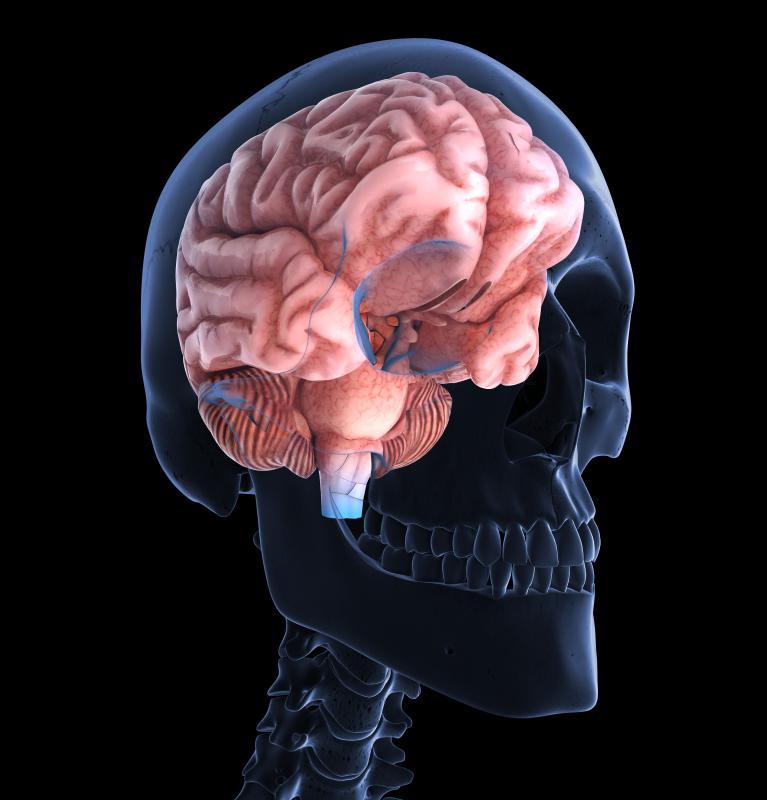At WiseGEEK, we're committed to delivering accurate, trustworthy information. Our expert-authored content is rigorously fact-checked and sourced from credible authorities. Discover how we uphold the highest standards in providing you with reliable knowledge.
What Is the Prosencephalon?
In the anatomy of the brain, the prosencephalon, also known as the forebrain, is a large set of structures consisting of the diencephalon and telencephalon. Diencephalon structures include the thalamus, hypothalamus, and other nuclei of grey matter, or neurons, near the third ventricle, a fluid-filled cushioning area. The telencephalon refers to the cerebral cortex, the largest area of the brain, along with its white matter projections and support cells, and the basal ganglia.
During development, the brain initially forms as three regions, and later develops into five. These developmental regions consist of the prosencephalon, the mesencephalon or midbrain, and the rhombencephalon or hindbrain. Even during this period, the prosencephalon manages key functions such as emotional display, feeding, sleeping, and body temperature. Only later does this region separate into two distinct structures in higher mammals.

In humans and other higher mammals, there are many functions regulated by the prosencephalon. The cerebrum is involved in processing most types of sensory information, as well as coordinating and executing motor functions. Just as importantly for humans, it plays a role in higher-order processes like decision-making, memory, speech, and comprehension.

Several other critical processes are mediated in the diencephalon. Neurons in the thalamus receive incoming sensory signals, and route them to appropriate regions in the cerebral cortex. The nearby hypothalamus releases hormones that regulate sexual behavior, and regulates automatic processes like hunger, thirst, and circadian rhythms influencing sleep. Glands like the pituitary and pineal are also located here, where they assist in growth and homeostasis functions.

Proper development of the prosencephalon requires the presence of chemical signals released at appropriate times. At first, neural and stem cells begin to develop in a small area called the neuraxis. Cells on the anterior side of the neuraxis secrete proteins that stimulate differentiation between anterior cells and those at the posterior end of the neuraxis. Anterior cells develop into the prosencephalon, and posterior cells eventually become parts of the midbrain and hindbrain.
Following this initial division between anterior and posterior, there is another activation of signaling proteins. Cells at the dividing line between neural and non-neural tissue on the anterior side release proteins, such as the network of proteins called Wnt. These signals induce the growth and differentiation of distinct prosencephalon tissue. Telencephalon and diencephalon tissue form shortly afterward, but they still comprise a single structure. Other proteins help this brain region to develop properly along dorsal to ventral lines, and to differentiate into discrete structures.
AS FEATURED ON:
AS FEATURED ON:













Discussion Comments
I have read about Prosencephalon Disease in animals. Have you heard of anything in humans? The comments above about autism are what I am researching. Children with autism often pressure seek with the frontal lobe and the temporal lobes. Animals that have Prosencephalon Disease or Toxic Exposures do the same type of pressing with the forehead. Does anyone have any information you can provide me and what is your background? I am searching for answers and research and welcome all that can help. Lee
I have heard about the difficulty children with autism can have with processing or integrating sensory information, but I cannot say if that is the area of the brain that is responsible for that certain sensory symptom in autism.
I have heard of another disorder directly related to the prosencephalon called Holoprosencephaly. In this disorder the prosencephalon does not develop during the embryo stage of development.
They say that this is also relatively common!
I work with children with autism so I was curious if the sensory information that the Prosencephalon was responsible for was the sensory processing information that we hear so much about and see so much with this disorder?
Sometimes we have to really work hard at moving past a child with autism's need for stimulation before they can concentrate, notice, etc. what we are trying to teach them.
Post your comments